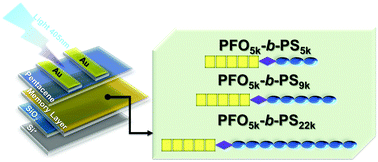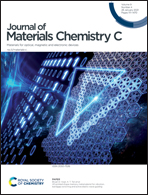Improving the performance of photonic transistor memory devices using conjugated block copolymers as a floating gate†
Abstract
We report the synthesis, morphology and photo-memory device applications of a block copolymer (BCP) consisting of poly(9,9-dioctylfluorene) (PFO) and polystyrene (PS). Three BCPs were designed with various PS contents to manipulate the structure–performance relationship of the polymer electrets in a photonic field-effect transistor-type (FET) memory device. The memory device using the BCP electret exhibited a dynamic switching behaviour with photo-writing and electrical-erasing processes. We found that the BCPs with a high PS content provided improved device performance, which could be explained by two aspects: (1) the enhanced β-conformation of the PFO strengthened the electron-trapping capability, (2) the well-dispersed and microphase-separated morphology stabilized the trapped electrons on the interface of PFO and PS domains. Consequently, PFO5k-b-PS22k outperformed in terms of the photo-responding current along with having a high current on/off ratio of 104 and exhibited a retention time of more than 10 000 s. Our experimental results revealed the effectiveness of using the design based on a BCP for application in photonic FET memory devices.

- This article is part of the themed collection: Journal of Materials Chemistry C Lunar New Year collection 2022


 Please wait while we load your content...
Please wait while we load your content...